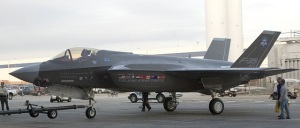 I understand the reluctance to simply walk away from the Pentagon's plan to buy a fleet of Lockheed Martin F-35 Lightning Joint Strike Fighters. But the time has come to either cancel or significantly downsize the program.
I understand the reluctance to simply walk away from the Pentagon's plan to buy a fleet of Lockheed Martin F-35 Lightning Joint Strike Fighters. But the time has come to either cancel or significantly downsize the program.
On an emotional level, that's a hard recommendation to make. The plane, which is being developed to replace several fighter, strike, and ground attack aircraft now on use, is a sleek, technologically advanced thing of beauty. And, if we could ever get it to work the way it should, it would be an amazingly capable and lethal weapon of war. In short, the F-35 is - or at least has the potential to be - very cool.
Add that the usual Washington considerations - like bureaucratic inertia, jobs in key Congressional districts and lawmakers' innate desire to keep key defense contractors well fed - it would be hard for the Pentagon and Congress to completely give up on the F-35.
However, after years of big cost overruns and delays, along with scary technical glitches and performance problems, it's still not clear when, if ever, the F-35 will be deployable. A beautiful fighter plane loses a lot of its allure if it can't be used in combat. Like a vintage Italian sports car with a bad transmission and an oil leak, the F-35 is cooler in theory than it is in reality. That's especially true when one considers the cost.
Building, housing and maintaining the F-35 s now estimated at almost $1.5 trillion over the life of the program. And there is reason to think that's a low-ball estimate.
According to a report issued in September by the Government Accountability Office (GAO), "the F-35 program has experienced cost, schedule, and performance problems that have put it 7 years behind schedule and significantly over its original budget. " Despite all that, the report added, the Department of Defense (DOD) still does not know how much the plane will cost to buy and maintain, or whether it will be able to pay for it. According to the report:
One key decision is for DOD to determine what it can realistically afford with respect to the F-35 program, but until it identifies affordability constraints tied to the military services' budgets, it will continue to develop and field the most costly weapon system program in history without knowing whether the Air Force, Navy, or Marine Corps can pay for it. Furthermore, while DOD has begun testing and fielding the F-35 at sites around the country, the program faces several risks ... and uncertainties related to technical data rights, which could adversely affect DOD's sustainment strategy. If these risks remain unaddressed, sustainment costs could potentially increase well beyond current estimated levels, and operational readiness could suffer.
OK, the F-35 program is a huge, expensive mess and everyone knows it. But we really need this plane, right? Not necessarily.
As Ryan Alexander, president of Taxpayers for Common Sense (TCS) points out in an Oct. 1 column, our military has more affordable options that could keep the country safe while saving billions of dollars. According to TCS, those include purchasing more F-15E Strike Eagle jets and modernizing the military's proven fleets F-22 Raptor, F-15 Eagle and F-16 Falcon aircraft.
Given these options, Alexander writes, "I hope Congress keeps a microscope on this massive weapon system. A trillion and a half dollars is too much to squander like this." I agree.
Unless and until the U.S. military finds a way to make the F-35 a better and more affordable option, TSC's recommendations make a lot of sense. Continuing to throw huge amounts money at a weapons program that has failed to deliver a usable airplane simply doesn't.